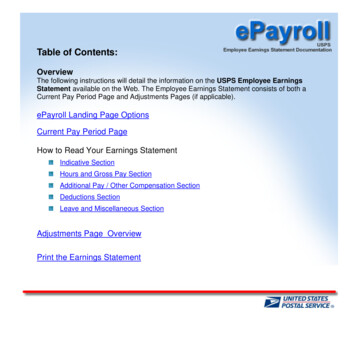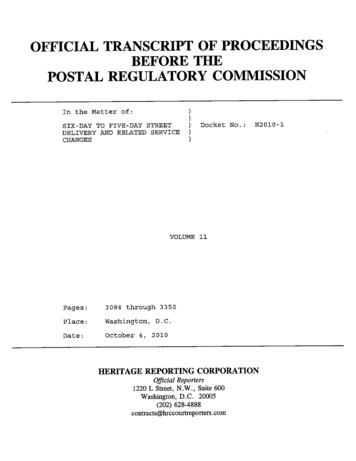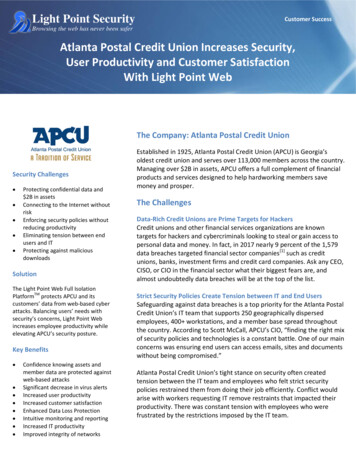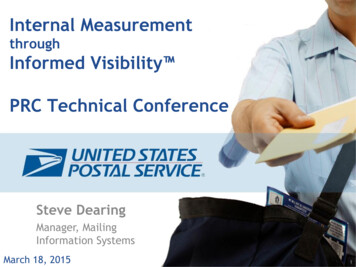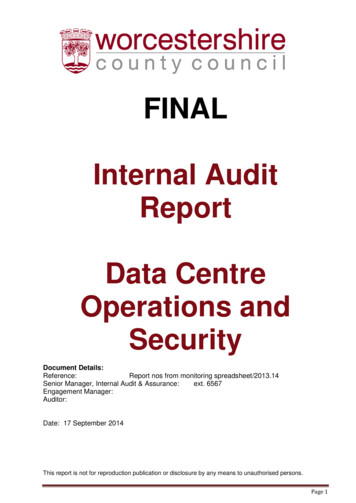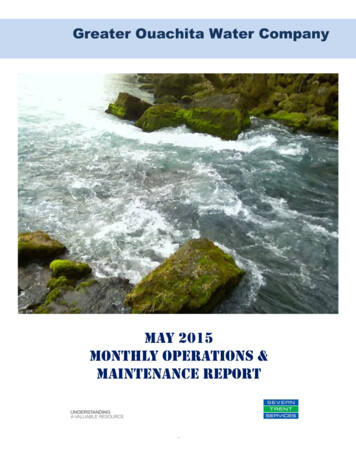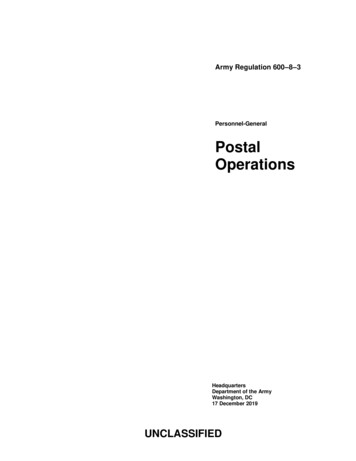
Transcription
Army Regulation artersDepartment of the ArmyWashington, DC17 December 2019UNCLASSIFIED
SUMMARY of CHANGEAR 600–8–3Postal OperationsThis regulation is certified current as of 17 December 2019. Aside from the following administrative changes, no otherchanges were made to certify the currency of this regulation--oUpdates boilerplates statements and signature authority (title page).oAdds the new recordkeeping requirements paragraph (para 1–5).oUpdates proponent for Army Official Mail to Deputy Chief of Staff, G–1 (paras 1–9 and B–2.)oRemoves the illustration of DA Form 7698, Unit Mail Room (UMR), Consolidated Mail Room (CMR), and PostalService Center (PSC) Inspection Checklist (formerly fig 2–1).
HeadquartersDepartment of the ArmyWashington, DC17 December 2019*Army Regulation 600–8–3Effective 16 March 2016Personnel-GeneralPostal OperationsHistory. This regulation is certified current as of 17 December 2019. Aside fromthe changes listed on the summary ofchange page no other content has beenchanged.Summary. This regulation prescribes thepostal operations function of the MilitaryPersonnel System.Applicability. This regulation applies tothe Regular Army, the Army NationalGuard/Army National Guard of the UnitedArmy internal control process. ThisStates, and the U.S. Army Reserve, unlessregulation contains internal control proviotherwise stated.sions in accordance with AR 11–2 andProponent and exception authority. identifies key internal controls that must beThe proponent agency of this regulation is evaluated (see appendix C).the Deputy Chief of Staff, G–1. The propoSupplementation. Supplementation ofnent has the authority to approve exceptionsthis regulation and establishment of comor waivers to this regulation that are conmand and local forms are prohibited withsistent with controlling law and regulations.out prior approval from the Deputy Chief ofThe proponent may delegate this approvalStaff, G–1 (DAPE–MP), 300 Army Pentaauthority, in writing, to a division chiefgon, Washington, DC 20310–0300.within the proponent agency or its direct reporting unit or field operating agency, in the Suggested improvements. Users aregrade of colonel or the civilian equivalent. invited to send comments and suggestedActivities may request a waiver to this reg- improvements on DA Form 2028 (Recomulation by providing justification that in- mended Changes to Publications and Blankcludes a full analysis of the expected bene- Forms) directly to the Commanding Genfits and must include formal review by the eral, U.S. Army Human Resources Comactivity’s senior legal officer. All waiver re- mand, (AHRC–PDP– P), 1600 Spearheadquests will be endorsed by the commander Division Avenue, Department 480, Fortor senior leader of the requesting activity Knox, KY 40122–5408.and forwarded through their higher headDistribution. This regulation is availablequarters to the policy proponent. Refer toin electronic media only and is intended forAR 25–30 for specific guidance.the Regular Army, the Army NationalGuard/Army National Guard of the UnitedStates, and for U.S. Army Reserve.Contents (Listed by paragraph and page number)Chapter 1Introduction, page 1Section IGeneral, page 1Purpose 1–1, page 1References and forms 1–2, page 1Explanation of abbreviations and terms 1–3, page 1Responsibilities 1–4, page 1Records management (recordkeeping) requirements 1–5, page 1Manpower resources 1–6, page 1Levels of work 1–7, page 2The Unit Postal Operations Program 1–8, page 2Section IIPrinciples and Standards, page 2Principles of support 1–9, page 2Standards of service 1–10, page 2*This regulation supersedes AR 600–8–3, dated 7 January 2013.AR 600–8–3 17 December 2019UNCLASSIFIEDi
Contents—ContinuedChapter 2Mailroom and Army Post Office Operations, page 3Section IGeneral, page 3Designation of mailroom 2–1, page 3Duties of unit mail personnel 2–2, page 3Appointment of unit mail personnel and military post office personnel 2–3, page 3Qualifications of unit mail personnel and military post office postal personnel 2–4, page 4Qualifications of civilian mail clerks, alternates, and mail orderlies 2–5, page 5Relief of unit mail personnel 2–6, page 5Training 2–7, page 5Access to work areas or security 2–8, page 5Postal offenses and losses 2–9, page 5Inspections 2–10, page 6Section IIControl and Maintenance of DD Form 285, page 6Rules for control and maintenance of DD Form 285 2–11, page 6Steps for control and maintenance of DD Form 285 2–12, page 6Section IIIPostal Offense Reporting, page 7Rules for postal offense reporting 2–13, page 7Steps for postal offense reporting 2–14, page 7Section IVHandling Catastrophes, page 7Rules for handling catastrophes 2–15, page 7Steps for handling catastrophes 2–16, page 7Section VAssignment or Withdrawal of Receptacles, page 8Rules for assignment or withdrawal of receptacles 2–17, page 8Steps for assignment or withdrawal of receptacles 2–18, page 8Section VIMaintenance of Receptacles and DD Forms 2262, page 8Rules for maintenance of receptacles and DD Forms 2262 2–19, page 8Steps for maintenance of receptacles and DD Forms 2262 2–20, page 8Section VIIDelivering Mail through Receptacles, page 9Rules for delivery of mail through receptacles 2–21, page 9Steps for delivering mail through receptacles 2–22, page 9Section VIIIMaintenance of Keys and Combinations for Receptacles, page 9Rules for maintenance of keys and combinations of receptacles 2–23, page 9Steps for maintenance of keys and combinations of receptacles 2–24, page 9Section IXChecking Assigned Receptacles, page 10Rules for checking assigned receptacles 2–25, page 10Steps for checking assigned receptacles 2–26, page 10Maintenance of postal operations records 2–27, page 10iiAR 600–8–3 17 December 2019
Contents—ContinuedChapter 3Mail Processing, page 11Section IGeneral, page 11Incoming mail 3–1, page 11Outgoing mail 3–2, page 11Free mailing privileges 3–3, page 11Accountable mail 3–4, page 11General delivery 3–5, page 11Intra-theater delivery service 3–6, page 11Section IIReceiving the Mail, page 11Rules for receiving the mail 3–7, page 11Steps for receiving the mail 3–8, page 12Section IIIProcess Incoming Mail, page 12Rules for processing incoming mail 3–9, page 12Steps for processing incoming mail 3–10, page 12Section IVDelivering the Mail, page 12Rules for delivering the mail 3–11, page 12Steps for delivering the mail 3–12, page 13Section VProcessing Dangerous Mail, page 13Rules for processing dangerous mail 3–13, page 13Steps for processing dangerous mail 3–14, page 13Chapter 4Mail Directory Service and DA Forms 3955, page 14Mail directory 4–1, page 14Rules for preparing DA Forms 3955 4–2, page 14Steps for preparing DA Forms 3955 4–3, page 14Chapter 5Redirecting and Processing Mail for Casualties, page 14Disposition of undeliverable mail 5–1, page 14Rules for redirecting mail 5–2, page 14Steps for redirecting mail 5–3, page 15Rules for processing mail for casualties 5–4, page 15Steps for processing mail for casualties 5–5, page 15Chapter 6Money Orders and Stamps, page 15Purchase of money orders and stamps by unit mail clerks 6–1, page 15Steps for purchasing United States Postal Service money orders and stamps 6–2, page 15AppendixesA. References, page 17B. Delivery of United Parcel Service Material by Unit Mailrooms, page 19C. Internal Control Evaluation, page 20AR 600–8–3 17 December 2019iii
Contents—ContinuedTable ListTable 2–1: Control and maintenance of DD Form 285, page 6Table 2–2: Postal offense reporting, page 7Table 2–3: Handling catastrophes, page 7Table 2–4: Assignment or withdrawal of receptacles, page 8Table 2–5: Maintenance of receptacles and DD Forms 2262, page 8Table 2–6: Delivering mail through receptacles, page 9Table 2–7: Maintenance of keys and combinations for receptacles, page 10Table 2–8: Checking assigned receptacles, page 10Table 3–1: Receive the mail, page 12Table 3–2: Processing incoming mail, page 12Table 3–3: Delivering the mail, page 13Table 3–4: Processing dangerous mail, page 13Table 4–1: Preparing DA Forms 3955, page 14Table 5–1: Redirecting mail, page 15Table 5–2: Processing mail for casualties, page 15Table 6–1: Purchasing U.S. Postal Service money, page 16GlossaryivAR 600–8–3 17 December 2019
Chapter 1IntroductionSection IGeneral1 –1. PurposeThis regulation prescribes the postal operations function of the Human Resources Support System. It is linked to ArmyRegulation (AR) 600–8 and provides principles of support, standards of service, policies, tasks, rules, and steps governingwork required in the field (garrison and tactical environment) to support postal operations.1 –2. References and formsSee appendix A.1 –3. Explanation of abbreviations and termsSee the glossary.1 –4. Responsibilitiesa. The Deputy Chief of Staff, G–1 will establish postal operations policies related to the processing of personal mail.b. The Commanding General, U.S. Army Human Resources Command will—(1) Establish standards and operating tasks for the Unit Postal Operations Program.(2) Ensure the Department of the Army Postal Program utilizes annual inspection and annual Custodian of Postal Effects (COPE) audits to evaluate compliance with all policies and regulatory guidance.c. The Commandant, Adjutant General School will ensure lesson programs or instructions incorporate the provisionsof this regulation.d. Commanders of Army commands (ACOMs), Army service component commands (ASCCs), direct reporting units,installations, and activities will comply with the requirements set forth in this regulation.e. Commanders of ASCCs, U.S. Army Installation Management Command, and U.S. Forces Command further shall—(1) Appoint command postal representatives in writing.(2) Ensure the appropriate authorities inspect and audit postal functions and activities at least annually. ASCC commandpostal representative will maintain copies of all annual inspections and COPE audits conducted on activities under theirjurisdiction for a period of two years.(3) Copies will be sent to DA Postal via email to armypostal@mail.mil by close of business on the last day of eachmonth. Negative replies are required.f. Separate unit commanders will—(1) Administer the Army's unit mailroom (UMR) operations.(2) Assign a primary and alternate E–6 or senior or civilian (General Schedule (GS)-6 or higher) as the Unit PostalOfficer, to supervise the unit mail handling operation.(3) Ensure unit personnel notify the UMR, Community or Consolidated Mail Room (CMR) or Postal Service Center(PSC) of a change in status that affects their mail delivery.(4) Notify the local servicing post office as soon as possible about a deployment and coordinate any required mailrouting changes.1 –5. Records management (recordkeeping) requirementsThe records management requirement for all record numbers, associated forms, and reports required by this regulation areaddressed in the Records Retention Schedule-Army (RRS–A). Detailed information for all related record numbers, forms,and reports are located in Army Records Information Management System (ARIMS)/RRS–A athttps://www.arims.army.mil. If any record numbers, forms, and reports are not current, addressed, and/or published correctly in ARIMS/RRS - A, see DA Pam 25–403 for guidance.1 –6. Manpower resourcesThe Manpower Staffing Standards System recognizes the postal operations function as being the functional responsibilityof the Personnel Operations Work Center of the military personnel division. Manpower officials will use the number ofAR 600–8–3 17 December 20191
Soldiers supported, as authorized in the table of organization and equipment and table of distribution and allowancesauthorization documents, as the workload factor to determine the manpower authorizations.1 –7. Levels of workPostal operations in the field are performed at three primary levels: unit, battalion (BN), and installation (or some equivalent organization in the tactical force). The main focus of this guidance is on unit and BN levels.1 –8. The Unit Postal Operations ProgramThe Unit Postal Operations Program, a subprogram of the Army Postal Operations Program, is a military personnel function that provides the unit commander with guidance for processing personal mail in the field, in support of Departmentof Defense (DOD) 4525.6–M. The program consists of the following subfunctions:a. Mailroom operations.b. Mail processing.c. Mail directory service.d. Mail redirect.e. Postal finance service.Section IIPrinciples and Standards1 –9. Principles of supportThe functions of the Human Resources Support System in relation to unit postal operations are to—a. Manage and operate a postal program to move and deliver personal mail to the deployed force and on the battlefieldto contribute to the fighting will of Soldiers.b. Provide prompt, efficient, and economical service in support of the DOD mission and consistent with the requireddelivery date, security, accountability, and class of mail.c. Support the Army's personnel life-cycle function of sustainment.1 –10. Standards of servicea. The Army Postal Operations Program. This program—(1) Is a wartime military personnel process.(2) Is resourced in table of distribution and allowances linkage for postal finance service and the human resourcescompany for all other functions.(3) Is resourced in table of organization and equipment postal units on the battlefield and in the deployed force as partof an integrated personnel team.(4) Deploys with the tactical force.(5) Is the functional responsibility of the Personnel Operations Work Center (and its tactical counterpart on the battlefield).(6) Provides service, as a minimum, equal to that provided by the United States Postal Service (USPS) to the publicsector.(7) Prohibits the use of DOD personnel and resources to duplicate services that the USPS, by law or agreement, isobligated to provide.b. The network.(1) The Commanding General, U.S. Army Human Resources Command is the functional proponent for personal mailand for the Army's postal system.(2) The Deputy Chief of Staff, G–1 is the proponent for Army official mail.(3) Official mail moves within the Army's postal system before delivery to information systems clerks, who are typically located in the Chief Information Officer/G–6 section.(4) The delivery network will connect command and control headquarters and the postal units with daily delivery service whenever possible.(5) The postal network will provide delivery service to units of the allied forces when called for by international orbilateral agreements with the United States.(6) Army postal units will be deployed on the battlefield as an integrated part of the personnel service support network.(7) Postal units will be colocated on the battlefield with the human resources company and finance service unit whenever possible.2AR 600–8–3 17 December 2019
(8) The corps postal network will establish local transportation requirements so as to deliver mail and pick up mail fromthe postal platoons.(9) Adjutant generals and their counterparts will arrange local transportation in order to deliver to subordinate commands.(10) The postal network will provide delivery service to units of other U.S. Services, as required by interservice supportagreements.c. Postal finance services.(1) Personal packages will not be accepted or moved in the network until a base operations force can be established tosell stamps and process packages.(2) Official mail will be metered until it is no longer practical.d. Casualty mail.(1) Redirect service will be synchronized with the Casualty Management System to safeguard against the prematurerelease of casualty information and deliver mail to Soldiers within the medical system.(2) Mail for killed in action or missing in action Soldiers will be dispatched by the BN adjutant (S1) to the TheaterCasualty Operations Center within 24 hours of confirmation of Soldiers’ status.(3) Mail for medically evacuated Soldiers will be worked for 30 days at the direct support level and 30 days at thegeneral support level to identify the gaining medical facility.(4) Mail for casualty Soldiers will be labeled as “search,” forwarded to theater level casualty section, and verified therebefore it is returned to the sender or forwarded to next of kin (NOK).(5) Mail for evacuated Soldiers will be redirected to the gaining hospital.e. Objective. Theaters, corps, divisions, and all postal units will have access to an automated mail routing scheme.Chapter 2Mailroom and Army Post Office OperationsSection IGeneral2 –1. Designation of mailroomIndividual unit(s) and garrison commanders will provide a separate and secure room or facility with the space and equipment needed to operate a mailroom or PSC. The room or facility designated will be in compliance with the requirementsspecified in DOD 4525.6–M, Paragraphs C13.5, C13.7, and C15.10.4.2 –2. Duties of unit mail personnela. The unit or PSC postal officer and the alternate postal officer will comply with the specific requirements outlined inDOD 4525.6–M, Chapter C15.b. Unit mail clerks (UMCs) or orderlies will perform and comply with the duties and responsibilities outlined in DOD4525.6–M, Chapter C15.2 –3. Appointment of unit mail personnel and military post office personnela. Commanders will appoint, in writing—(1) A unit postal officer.(2) An alternate postal officer, who will fulfill the duties of the unit postal officer in his or her absence. The appointedpostal officer and alternate postal officer cannot be individuals who work in, or have worked in the mailroom during thepast 12 months.b. Commanders will appoint a UMC and at least one alternate UMC using DD Form 285 (Appointment of MilitaryPostal Clerk, Unit Mail Clerk or Mail Orderly). Commanders may not exceed a total of three alternates unless operating aCMR. In this case he or she may appoint one alternate for each unit supported. The unit commander or the unit postalofficer may sign the DD Form 285 as the appointing authority.c. Unit commanders (or head of a headquarters staff section or civilian agency) who do not operate a UMR, will useDD Form 285 to appoint mail orderlies, who will only receive mail from a mailroom.d. Non-DOD agencies receiving mail through military postal activities will designate agency mail clerks or orderlieson DD Form 285, which will be provided by the servicing military postal activity. These personnel must meet the qualifications established by the appointing agency.AR 600–8–3 17 December 20193
e. Foreign nationals may be appointed as UMCs or orderlies provided the requirements of DOD 4525.6–M, paragraphC15 are complied with. These personnel are not authorized to purchase stamps or money orders for unit personnel unlessthey are authorized use of the military postal servicing facility. Additionally, registered mail will not be handled or turnedover to these personnel.f. Transient personnel (including temporary or summer hire personnel, in-processing personnel, and personnel within30 days of departure) will not be appointed as unit mail service personnel.g. Appointments need not be renewed if the appointing official changes.h. Commanders of postal units shall appoint a Military Postal Clerk (MPC), Financial Postal Clerk, COPE, and PostalFinance Officer (PFO) using DD Form 2257 (Designation/Termination MPC–FPC–COPE–PFO) and in accordance withDOD 4525.6–M.2 –4. Qualifications of unit mail personnel and military post office postal personnela. The postal officer or mailroom supervisor and alternate will—(1) Be a U.S. citizen, if required to handle official accountable and first class mail which may contain classified material.(2) Be an officer or noncommissioned officer in the rank of E–6 or above, if military.(3) Be in the grade of general series (GS)–6 equivalent or above, if civilian.b. UMCs, alternates, and orderlie
(3) Ensure unit personnel notify the UMR, Community or Consolidated Mail Room (CMR) or Postal Service Center (PSC) of a change in status that affects their mail delivery. (4) Notify the local servicing post office as soon as pos
